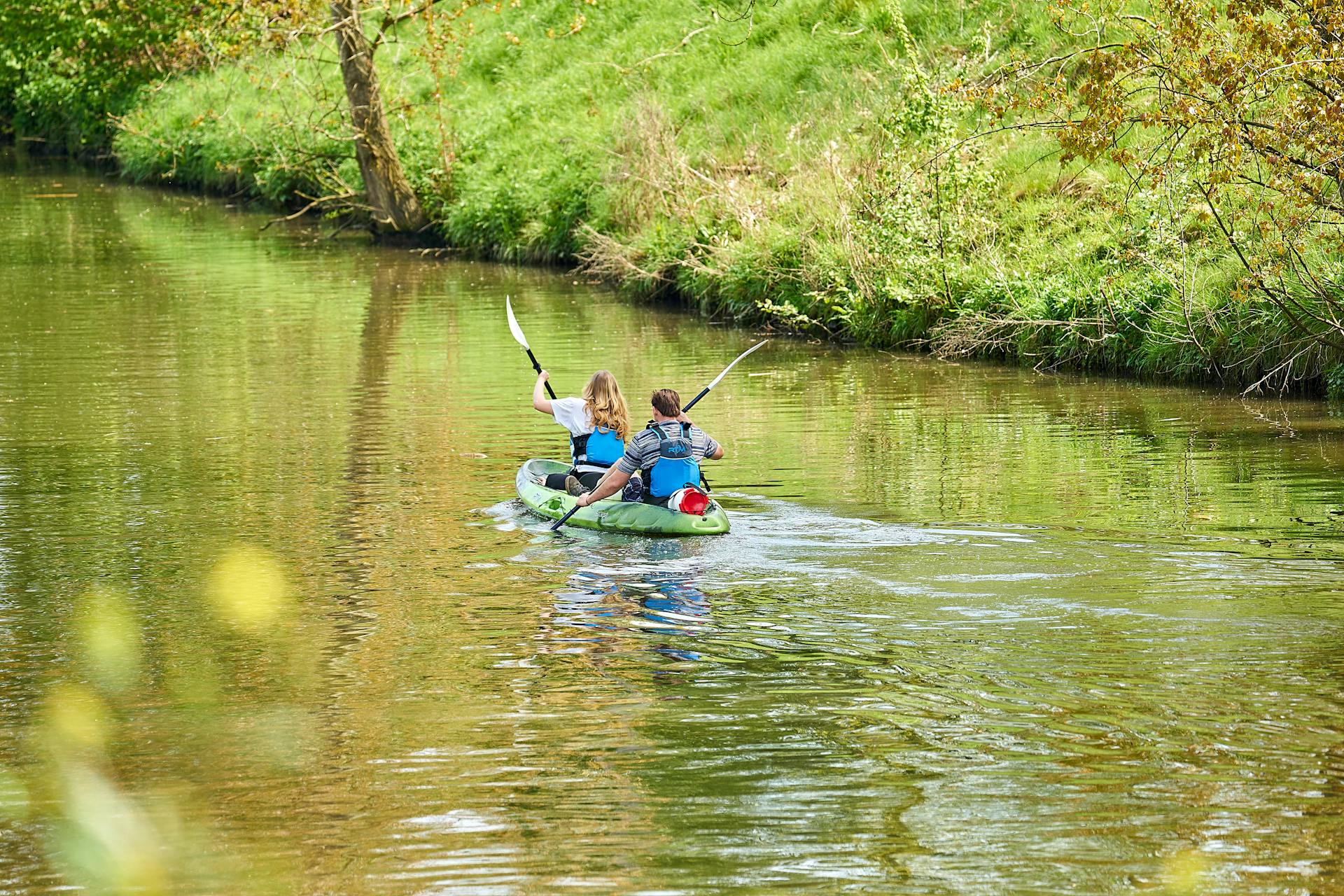Kayak camping is an exhilarating way to immerse yourself in nature, offering a unique combination of adventure, tranquility, and physical challenge. However, while the allure of paddling through serene lakes, winding rivers, and scenic coastal waters can be tempting, it’s important to approach kayak camping with a solid understanding of safety precautions. Whether you’re a seasoned paddler or a beginner, being aware of the risks and knowing how to mitigate them is key to ensuring that your kayaking adventure remains enjoyable, rewarding, and safe.
In this guide, we’ll walk through essential kayak camping safety tips you can’t afford to ignore, covering everything from gear choices and water navigation to weather preparedness and emergency procedures. By following these guidelines, you’ll be better equipped to handle challenges on the water and enjoy your kayaking trip with confidence.
1. Always Wear a Personal Flotation Device (PFD)
The first rule of safety on the water is simple, yet it’s one that some kayakers still overlook: wear a personal flotation device (PFD). Even experienced paddlers, particularly those in calm waters, might feel comfortable going without it. However, accidents can happen unexpectedly—whether from capsizing, hitting an obstruction, or even just losing balance—so it’s essential to wear your PFD at all times while kayaking, even if you’re a strong swimmer.
When choosing a PFD, it’s important to find one that fits snugly but comfortably. PFDs come in various styles, including vest-style and belt packs, with varying degrees of buoyancy. For kayak camping, where you’ll likely be in open water for extended periods, opt for a high-performance PFD with sufficient buoyancy and the right features (such as pockets for storing small items) to meet your needs.
2. Plan Your Route and Know the Waters
One of the most important safety precautions when kayak camping is thoroughly planning your route. This means not only mapping out where you’ll launch and land, but also understanding the type of water you’ll be paddling on, such as rivers, lakes, or coastal regions. The water’s current, tides, and possible obstacles all influence your safety.
- Study Water Conditions: Research the water conditions for your trip. If you’re kayaking in a river, check for potential rapids, changing currents, and any points where the water might be especially challenging. For ocean kayaking, be sure to check the tides and understand the coastline’s geography.
- Weather Patterns: Always check the weather forecast before heading out. If you’re going to be on the water for several days, be sure to check weather predictions for the entire duration of your trip. Sudden storms, high winds, and other adverse conditions can make kayaking dangerous.
- Know Your Limitations: Don’t take on more than you can handle. If you’re new to kayaking or haven’t paddled in certain conditions before, stick to calm waters until you’re more experienced.
3. Ensure Your Kayak Is in Good Condition
Before setting out on a kayak camping adventure, make sure your kayak is in good working order. A malfunctioning kayak can lead to an emergency situation in the middle of your trip. Take time to inspect the kayak’s hull, paddles, and accessories to ensure everything is functioning correctly.
- Check for Leaks: Inspect your kayak for any cracks or holes that could lead to water entering the vessel. If you find any, repair them before heading out on the water.
- Inspect Paddles and Other Gear: Ensure your paddles are free of cracks or damage. Bring along a spare paddle just in case. Additionally, check any other gear you plan to bring, including ropes, dry bags, and camping equipment, to make sure everything is in good condition.
4. Dress Appropriately for the Conditions
What you wear can have a huge impact on your safety while kayak camping, especially when you consider the water temperature and weather conditions. When paddling, you’ll often be in close contact with water, so it’s essential to wear clothing that keeps you warm, dry, and protected.
- Dress in Layers: Layering your clothing allows you to adjust to changing conditions. Start with a moisture-wicking base layer to keep sweat off your skin, followed by insulating layers to retain body heat. For extreme cold, consider a dry suit or a wetsuit to keep your body temperature stable if you fall into the water.
- Stay Dry: Water-resistant clothing is essential for staying dry, but it’s also a good idea to bring along a dry bag for storing extra clothing, food, and other gear. If you’re kayak camping in cold temperatures, avoid cotton as it retains water, which can lower body temperature and increase the risk of hypothermia.
- Protect Your Skin: Sunburn is a common problem for kayakers, especially those spending extended hours outdoors. Protect your skin with a high SPF sunscreen, and wear a hat, sunglasses, and a long-sleeve shirt for additional protection.
5. Stay Hydrated and Nourished
While kayaking is a physically demanding activity, it’s easy to forget the importance of staying hydrated and nourished, especially when you’re focused on paddling or setting up camp. Dehydration and poor nutrition can quickly take a toll on your energy and concentration, making it more difficult to respond to safety threats.
- Bring Enough Water: Always bring sufficient water for your trip, especially if you’re kayaking in remote areas where freshwater sources are scarce. Invest in a durable, portable water filter if you plan to refill from natural sources like streams or rivers.
- Pack Energy-Rich Snacks: Kayak camping often requires a good deal of physical exertion, so pack lightweight, high-energy snacks like energy bars, trail mix, and dried fruit to keep your energy levels up during the day. These foods are easy to store and won’t weigh you down.
6. Know How to Self-Rescue
Even with the best precautions in place, capsizing is always a possibility. Knowing how to self-rescue and re-enter your kayak after a fall is an essential skill for any kayaker.
- Practice Wet Exits: Before embarking on a kayak camping trip, practice wet exits in calm, controlled conditions. Learn how to safely exit your kayak and swim to shore in case of an emergency.
- Perform a Kayak Recovery: Once you’ve exited your kayak, it’s essential to know how to right it and climb back in. A T-rescue (where another paddler assists) is a useful technique if you’re kayaking with a partner, but you should also be familiar with solo recovery techniques, such as the “paddle float” method.
- Keep a Whistle and Rope Handy: A whistle can be a lifesaver if you need to signal for help. A rope is also essential for towing a kayak in case of an emergency, and it’s a good idea to have it easily accessible at all times.
7. Understand the Importance of Leave No Trace Principles
Kayak camping offers an opportunity to experience nature at its finest, but it also carries a responsibility to leave the environment as you found it. Responsible camping practices protect both the environment and your safety.
- Pack Out All Trash: Take all waste, including food scraps and toilet paper, with you when you leave. Leaving behind trash or food waste can attract animals and pose a hazard to the natural ecosystem.
- Respect Wildlife: Kayak camping often takes you into pristine natural habitats, so be mindful of wildlife. Avoid disturbing animals, and maintain a safe distance from any wildlife you encounter on your journey.
- Follow Local Regulations: Many parks and waterways have specific regulations regarding camping, fires, and fishing. Be sure to research local rules and abide by them during your trip to ensure you’re not only staying safe but also preserving the environment.
8. Monitor Weather Conditions Throughout the Trip
Even if the forecast calls for clear skies and calm waters, weather conditions can change rapidly while you’re out on the water. Stay vigilant and monitor the conditions around you to ensure you don’t get caught in dangerous situations.
- Be Aware of Changing Winds and Tides: Strong winds and shifting tides can make kayaking much more difficult, especially in open water. If you notice weather patterns changing, consider heading for shelter or returning to shore if possible.
- Seek Shelter During Storms: If you’re caught in a storm, look for a safe place to land and wait it out. Avoid kayaking during lightning storms, as water is a natural conductor of electricity.
9. Carry Emergency Gear
Accidents happen when we least expect them, so it’s important to always carry emergency gear, no matter how experienced you are. A well-stocked emergency kit can make the difference between a minor setback and a major crisis.
- Basic First Aid Kit: Include bandages, antiseptic wipes, pain relievers, and any medications you may need in a waterproof first aid kit.
- Signal Flares or a Mirror: These items are essential for attracting attention if you need rescue.
- A Multi-tool or Knife: A multi-tool is invaluable for cutting rope, repairing gear, or handling various emergency situations.
10. Don’t Go Alone (If Possible)
While solo kayak camping can be a rewarding experience, it also comes with increased risks. If possible, it’s always better to kayak with a partner or a group. Not only does this offer an extra layer of safety, but it also provides the opportunity for shared responsibilities, especially in emergencies.
In conclusion, while kayak camping offers incredible opportunities for adventure and exploration, safety should always be your top priority. By following these tips, preparing adequately, and staying vigilant throughout your trip, you can enjoy the beauty and serenity of nature while minimizing risks. Whether you’re a beginner or an experienced paddler, these safety guidelines will help ensure your kayak camping trip remains as safe and enjoyable as possible.

